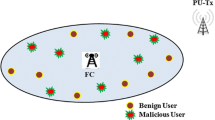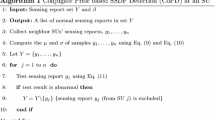Abstract
Cooperative spectrum sensing is widely accepted as an effective method to improve the reliability of spectrum sensing. However, spectrum sensing data falsification attacks (SSDF attacks) have posed serious threats to the credibility of cooperative spectrum sensing. This paper proposes an evidence theory-based anti-SSDF cooperative spectrum sensing scheme that eliminates the influence that malicious users have on the system performance in cooperative spectrum sensing. First, the data fusion center calculates the credibility according to the Jousselme distance between the evidence vectors. Then based on the credibility, the influence of malicious users on the fusion decision is reduced by using the weighted probability assignment for each cognitive user. Furthermore, to reduce the costs of collaboration and the amount of computation in applying evidence theory, the new scheme introduces a projection approximation algorithm at the local spectrum sensing process with weighted averaging in the data fusion phase. The results of the simulation show that the proposed scheme not only improves the system performance when malicious users initiate SSDF attacks, but also reduces the cooperative bandwidth and computational complexity.






Similar content being viewed by others
References
Akyildiz IF, Lo BF, Balakrishnan R (2011) Cooperative spectrum sens-ing in cognitive radio networks: a survey. Phys Commun 4(1):40–62
Celik A, Kamal AE (2016) Multi-objective clustering optimization for multi-channel cooperative spectrum sensing in heterogeneous green crns. IEEE Trans Cogn Commun Netw 2(2):150–161
Chen B, Willett PK (2005) On the optimality of the likelihood-ratio test for local sensor decision rules in the presence of nonideal channels. IEEE Trans Inform Theory 51(2):693–699
Chen L, Wang J, Li S (2007) An adaptive cooperative spectrum sensing scheme based on the optimal data fusion rule. In: Proc. 4th Int. symposium on wireless communication systems, pp 582–586
Chen KC, Chiang M, Poor H (2013a) From technological networks to social networks. IEEE J Sel Areas Commun 31(9):548–572
Chen X, Huang J, Li H (2013b) Adaptive channel recommendation for opportunistic spectrum access. IEEE Trans Mobile Comput 12(9):1788–1800
Eryigit S, Bayhan S, Tugcu T (2013) Energy-efficient multichannel cooperative sensing scheduling with heterogeneous channel conditions for CRNs. IEEE Trans Veh Technol 62(6):2690–2699
Han Y, Chen Q, Wang JX (2012) An enhanced D-S theory cooperative spectrum sensing algorithm against SSDF attack. Proc IEEE VTC 15(3):1–5
Jana S, Zeng K, Cheng W (2013) Trusted collaborative spectrum sensing for mobile cognitive radio networks. IEEE Trans Inf Foren Sec 8(9):1497–1507
Jeon WS, Lee DH, Jeong DG (2013) Collaborative sensing management for CRNs with reporting overhead. IEEE Trans Wireless Commun 12(2):595–605
Kailkhura B, Han YS, Brahma S et al (2015) Distributed Bayesian detection in the presence of Byzantine data. IEEE Trans Signal Process 63(19):5250–5263
Khader AH, Reja AH, Hussein AA et al (2015) Cooperative spectrum sensing improvement based on fuzzy logic system. Proc Comput Sci 58(3):4–41
Li FJ, Qian YH et al (2016) Multigranulation information fusion: a dempster-shafer evidence theory based clustering ensemble method. Inf Sci 1:58–63
Mishra SM, Sahai A, Brodersen RW (2006) Cooperative sensing among cognitive radios. Proc IEEE Int Conf Commun 4(9):1658–1663
Nguyen-Thanh N, Koo I (2009) An enhanced cooperative spectrum sensing scheme based on evidence theory and reliability source evaluation in cognitive radio context. IEEE Commun Lett 13(7):492–494
Nguyen-Thanh N, Koo I (2011) Evidence-theory-based cooperative spectrum sensing with efficient quantization method in cognitive radio. IEEE Trans Veh Technol 60(1):185–195
Peng Q, Zeng K, Wang J, et al. (2006) A distributed spectrum sensing scheme based on credibility and evidence theory in cognitive radio context. In: Proc IEEE 17th int. symposium on personal, indoor and mobile radio communications, pp 1–5
Qin T, Yu H, Leung C et al (2009) Towards a trust aware cognitive radio architecture. Acm Sigmobile Mobile Comput Commun Rev 13(2):86–95
Qin Z, Li Q, Hsieh G (2013) Defending against cooperative attacks in cooperative spectrum sensing. IEEE Trans Wireless Commun 12(6):2680–2687
Rawat A, Anand P, Chen H, Varshney PK (2011) Collaborative spectrum sensing in the presence of Byzantine attacks in cognitive radio networks. IEEE Trans Signal Process 59(2):774–786
Shafer G (1976) A mathematical theory of evidence. Princeton Univ. Press, New Jersey
Sharma RK, Rawat DB (2017) Advances on security threats and countermeasures for cognitive radio networks: a survey. IEEE Commun Surv Tutor 17(2):1023–1043
Vempaty A, Tong L, Varshney PK (2013) Distributed inference with Byzantine data: state-of-the-art review on data fascination attacks. IEEE Signal Process Mag 30(5):65–75
Vosoughi A, Cavallaro JR, Marshall A (2017) Trust-aware consensus-inspired distributed cooperative spectrum sensing for cognitive radio ad hoc networks. IEEE Trans Cogn Commun Netw 2(1):24–37
Wang J, Ghosh M, Challapali K (2011) Emerging cognitive radio applications: a survey. IEEE Commun Mag 49(3):74–81
Yang GS, Wang J, Luo J et al (2016) Cooperative spectrum sensing in heterogeneous cognitive radio networks based on normalized energy detection. IEEE Trans Veh Technol 65(3):1452–1463
Zeng K, Pawelczak P, Cabric D (2010a) Reputation-based cooperative spectrum sensing with trusted nodes assistance. IEEE Commun Lett 14(3):226–228
Zeng K, Pawelczak P, Cabric D (2010b) Reputation-based cooperative spectrum sensing with trusted nodes assistance. IEEE Commun Lett 14(3):226–228
Zhang L, Wu Q, Ding G et al (2014) Performance analysis of probabilistic soft SSDF attack in cooperative spectrum sensing. EURASIP J Adv Signal Process 10(1):1–9
Zhang L, Ding G, Wu Q et al (2015) Byzantine attack and defense in cognitive radio networks: a survey. IEEE Commun Surv Tuts 17(3):1342–1363
Acknowledgements
This work is supported in part by the National Natural Science Foundation of China (Grant no.61571250), the National Natural Science Foundation of Ningbo (Grant no. 2015 A610121), the Zhejiang Open Foundation of the MostImportant Subjects of Information and Communication Engineering (Grant no. xkx11401), and the K. C. Wong Magna Fund in Ningbo University. The Education Department of Fujian Province under Project Number JA15556, Youth Project of Ningde Normal University (2017Q105), School Innovation Team of the Ningde Normal University (2015T011) and project of the Fujian Provincial Natural Science Fund (2017I0016).
Author information
Authors and Affiliations
Corresponding author
Rights and permissions
About this article
Cite this article
Wang, H., Li, Y. & Chang, TC. An enhanced cooperative spectrum sensing scheme for anti-SSDF attack based on evidence theory. Microsyst Technol 24, 2803–2811 (2018). https://doi.org/10.1007/s00542-018-3744-2
Received:
Accepted:
Published:
Issue Date:
DOI: https://doi.org/10.1007/s00542-018-3744-2




